Below are some of my favorite mushroom books. They range in topic from general information to field guides, cookbooks, growing guides, and medicinal mushrooms. I’ve included the product description so you’ll know what they’re about, as well as my own thoughts.
Each book here makes learning about mushrooms easy and fun. The links will take you to the best deals on Amazon.
They’re all great reads, but if I haven’t included one of your favorites, contact me and let me know about it. I’m always looking for new mushroom reading material!
Jump to:
- Mycelium Running: How Mushrooms Can Help Save the World
- National Audubon Society Field Guide to North American Mushrooms (National Audubon Society Field Guides)
- Mushrooms Demystified
- Growing Gourmet and Medicinal Mushrooms
- 100 Edible Mushrooms
- Medicinal Mushrooms: An Exploration of Tradition, Healing, & Culture (Herbs and Health Series)
- All That the Rain Promises and More: A Hip Pocket Guide to Western Mushrooms
- Reishi Mushroom: Herb of Spiritual Potency and Medical Wonder
- The Complete Mushroom Book: Savory Recipes for Wild and Cultivated Varieties
- Morels
Mycelium Running: How Mushrooms Can Help Save the World

Paul Stamets
More mushrooms, less pollution! Yes, you heard right: growing more mushrooms may be the best thing we can do to save the environment.
Microscopic cells called “mycelium”—the fruit of which are mushrooms —recycle carbon, nitrogen, and other essential elements as they break down plant and animal debris in the creation of rich new soil.
What fungi expert Paul Stamets has discovered is that mycelium also breaks down hydrocarbons —the base structure in many pollutants. So, for instance, when soil contaminated with diesel oil is inoculated with strains of oyster mushroom mycelia, the soil loses its toxicity in just eight weeks.
In MYCELIUM RUNNING, Stamets discusses this revolutionary trend in mushroom cultivation and provides tips for choosing the appropriate species of fungi for various environmental purposes.
What I Love: This may be my favorite mushroom books ever. It’s extremely informative without too much overwhelming science for the layperson.
Paul Stamets provides boatloads of info on the mushroom life cycle as well many different ways of growing your own mushrooms, along with details on individual species and what they can do for you. He also includes a fascinating look at mycorestoration, the healing of environments through growing and propagating mycelium.
I love applicable knowledge, so I really appreciated all the experiments, tips, and ideas for growing mushrooms. Beginners will have what they need to get started, and advanced growers may learn something new.
This volume maintains a real feel of wonder and reverence for the mycological world. If you buy only one of the mushroom books on this page, I suggest this one!
National Audubon Society Field Guide to North American Mushrooms (National Audubon Society Field Guides)

Gary H. Lincoff
With more than 700 mushrooms detailed with color photographs and descriptive text, this is the most comprehensive photographic field guide to the mushrooms of North America. The 762 full-color identification photographs show the mushrooms as they appear in natural habitats.
Organized visually, the book groups all mushrooms by color and shape to make identification simple and accurate in the field, while the text account for each species includes a detailed physical description, information on edibility, season, habitat, range, look-alikes, alternative names, and facts on edible and poisonous species, uses, and folklore.
A supplementary section on cooking and eating wild mushrooms, and illustrations identifying the parts of a mushroom, round out this essential guide.
What I Love: I have a beat up copy of this book that I always keep in my car, and it never fails to come in handy. It’s easy to read and follow, with lots of helpful information and pictures.
No field guide is perfect, and this won’t help you identify every single mushroom in North America. That said, for a general guide that really helps with mushroom identification, this is a great place to start.
Mushrooms Demystified

David Arora
This is the be-all and end-all of mushroom books! Truly an encyclopedia of mushroom facts and lore, lavishly illustrated with full-color photographs, literally everything you need to know about mushrooms, edible or not.
Arora has taught mycology for close to twenty years and has hunted and photographed mushrooms across the North American continent. Threaded through the book are his wry and humorous observations and comments, making what could have been a rather dull, “just-the-facts, ma’am” reference book into a really enjoyable read.
The stunning photographs of the incredible variety of fungi are fascinating and eye-opening, and while the author gives clear and factual information, the mysterious allure of mushrooms in their countless shapes, sizes and colors is only increased by this huge and delightful book. –Mark Hetts
What I Love: This book obliterates the concept of boring field guides. David Arora provides all the high-quality information of a regular guide, presented in a very entertaining and witty writing style.
I’d highly recommend this fun book to both beginners and experienced students of mycology and mushroom hunting. Especially recommended for those who find normal field guides to be way too dry.
Growing Gourmet and Medicinal Mushrooms

Paul Stamets
After years of living in awe of the mysterious fungi known as mushrooms-chefs, health enthusiasts, and home cooks alike can’t get enough of these rich, delicate morsels. With updated production techniques for home and commercial cultivation, detailed growth parameters for 31 mushroom species, a trouble-shooting guide, and handy gardening tips, this revised and updated handbook will make your mycological landscapes the envy of the neighborhood.
PAUL STAMETS is the founder of Fungi Perfecti and codirector and founder of the Rainforest Mushroom Genome and Mycodiversity Preservation Project. He is the author of two seminal mushroom books, The Mushroom Cultivator and GROWING GOURMET AND MEDICINAL MUSHROOMS, has been published in numerous journals, and is presenting more lectures on mycology than he can keep track of.
An advisor and consultant to the Program for Integrative Medicine at the University of Arizona Medical School and the 1998 recipient of the Collective Heritage Institute’s Bioneers Award, Stamets lives in Kamilche Point, Washington with his collection of more than 250 medicinal mushroom cultures.
What I Love: This is one of the most serious mushroom books about cultivation, and contains all the information you need to get started or refine your technique. Paul Stamets covers everything in this one, from substrate selection and preparation to picking out a species, indoor growing, outdoor growing, cloning, fruiting parameters, and much more.
There’s some heavier science in this one, but I wouldn’t let that scare you off if you’re a motivated beginner. Those who were intimidated in biology class might want to start with his easier to understand volume Mycelium Running, and work their way up to this one.
I always love how Paul Stamets encourages experimentation with your own mushroom projects. Although he provides you with a wealth of information, he still suggests that you take it further by trying new stuff on your own. Thus with this definitive mushroom growing book he engenders more than just blind following of technique, but true curiosity.
100 Edible Mushrooms

Michael Kuo
With a dash of humor and a dollop of science, Michael Kuo selects the top 100 mushrooms best suited for cooking. Like Kuo’s very popular book Morels, 100 Edible Mushrooms is written in the author’s inimitable, engaging, and appealing style, taking the reader on the hunt through forest and kitchen in search of mycological pleasures and culinary delights.
Kuo describes in detail how to identify each species, where and when to find them, and how to cook them in creative and delicious recipes. The mushrooms presented in the book are the most often eaten varieties, and a description of the button mushrooms found in the grocery store is included. All of the mushrooms have at least one full-color illustration and some several more to aid in identifying and distinguishing look-alike and nonedible species.
An indispensable book for mushroom hunters, naturalists, and cooks.
What I Love: This is a fun and fact-filled book about edible mushrooms, written in Michael Kuo’s unique, amusing style. He includes identification information, a section on avoiding poisonous mushrooms, opinions on which ones taste the best (useful to know!), and the easiest mushrooms for beginners.
He also presents lots of great recipes and ways in which certain mushrooms should be prepared. For a mediocre cook such as myself, it really improved my mushroom meals.
I wouldn’t rely on this solely for identification. It’s important to have hands on experience with an expert and a more comprehensive field guide. Yet this is still a must have for anyone who enjoys mushrooms in the kitchen!
Medicinal Mushrooms: An Exploration of Tradition, Healing, & Culture (Herbs and Health Series)

Christopher Hobbs
This modern handbook for exploring and understanding the rich traditions of healing fungi in Eastern and Western cultures is the most complete work on the cultural, health-promoting and medicinal uses of mushrooms ever published!
Author Christopher Hobbs thoroughly documents and details the nutritional and health benefits of over 100 species of edible fungi.
What I Love: This book covers the benefits of medicinal mushrooms in an engaging and easy to understand manner. Hobbs outlines individual species, how to prepare them, and how they benefit the body.
A great introduction for anyone who’s interested in medicinal mushroom books!
All That the Rain Promises and More: A Hip Pocket Guide to Western Mushrooms

David Arora
Full-color illustrated guide to identifying 200 Western mushrooms by their key features.
What I Love: I’m convinced that David Arora can make anything fun. Of course, we all think that mushrooms are a fun topic to begin with, but sometimes “field guides” can be a little dry.
Not this one! Sure, Arora covers the necessary information such as safety tips, taxonomy, edibility, descriptions, etc. Yet he also includes a lot of hilarious and entertaining stories about people and mushrooms. This book is simply a classic, a really great read about mushrooms. It’s rivaled only by one of his other mushroom books, Mushrooms Demystified (above).
You don’t have to live in the Western United States to get a lot out of this. I live in New England and I still think this is one of the best mushroom books going!
Reishi Mushroom: Herb of Spiritual Potency and Medical Wonder

Terry Willard
Is the Reishi mushroom really wondrous? Reishi Mushroom – Herb of Spiritual Potency and Medical Wonder by Terry Willard Ph.D. (Sylvan Press, 1990) could certainly lead one to think so! This 167 page book is primarily written as a discussion between the author and his researcher Kenneth Jones.
What I Love: This is an interesting look at one herbalist’s experience with reishi, and is one of my favorite mushroom books on the subject. Although some of the claims seem a little miraculous to me, there is a lot of evidence for the health benefits of reishi. At the very least, it will pique your curiosity enough to want to try your own reishi experiments!
I purchased this book years ago for under $10 on Amazon. This book goes in and out of print, and sometimes becomes quite expensive. If you to Amazon and it seems like too much, I’d suggest shopping around for a better price. It’s a great book!
The Complete Mushroom Book: Savory Recipes for Wild and Cultivated Varieties

Antonio Carluccio
More than just a cookbook, Carluccio’s exuberant guide to gathering and eating higher fungi is actually both a field guide and a recipe book. The author, who learned to collect wild mushrooms and truffles as a young boy in his native Italy, brought his passion for the “quiet hunt,” and for refined gastronomy, with him to London, where he now owns a Covent Garden restaurant that specializes in serving his two favorite delicacies.
The first part of Carluccio’s book introduces readers to the pleasures of gleaning wild fungi. And it contains not only a fully illustrated catalog of commonly found mushrooms, but also a “code of conduct” for would-be collectors. The author does stress, however, that mushroom collecting cannot be learned from this volume alone and he repeatedly warns readers that their cache of fresh-picked fungi should be looked over by an expert before it is eaten.
This mushroom book’s second section, “The Recipes,” is easier to apply at home. In it, readers will find ways to prepare morels, porcini, portabellos, shiitakes and dozens of other edible fungi in soups, salads, and main dishes. Though the book is beautifully designed with elegant color photographs and useful sidebars, it’s recipes like Enoki Bundles wrapped with prosciutto and Morels Stuffed with Foi Gras that will keep gourmet cooks turning back to this volume again and again.
What I Love: Besides the fact that it makes me really hungry? The strength of this book lies in its recipes and cooking tips. There are lots of great hints on how to prepare your mushrooms so that their unique flavors really shine.
It also contains information on hunting and identification, but I wouldn’t purchase it for that alone as it’s not very comprehensive. Yet if you’re looking for great recipes, beautiful pictures, and advice on how to become a better cook with mushrooms than this is a great buy.
See customer reviews on Amazon
Morels

Michael Kuo
Join the hunt for one of the most sought-after mushroom marvels—the elusive morel.
Filled to the brim with information about the science and sport of finding, identifying, and savoring these world-renowned fungi, Morels is a far-ranging, reader-friendly book about one of America’s most popular and passionately pursued outdoor activities.
Author Michael Kuo brings years of morel-hunting experience to Morels, delivering detailed information in an engaging, readable style to seasoned morel hunters and beginners alike.
Morels includes extensive information on the art of hunting morels and on current scientific knowledge regarding these delectable fungi. In addition, Kuo compiles easy-to-understand information on the latest scientific research into morels, from studies into how they grow to DNA-based classification of species.
With over two hundred color photographs.
What I Love: An extremely well written and funny volume on morels. It’s also very comprehensive, covering everything from growing science to morel culture. Thus it’s not just a tome about morels, but about people too.
Michael Kuo has a very fun and engaging writing style. This is one of the best mushroom books on just morels that you’ll find!
There you have it! Ten great mushroom books, although by no means an exhaustive list.
If you have some favorite mushroom books that are not listed here, feel free to let me know!

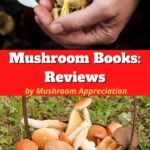
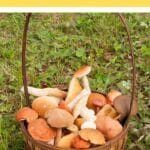
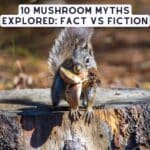
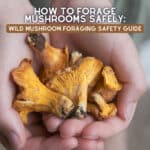
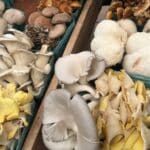
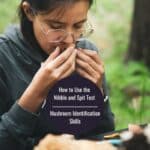
Leave a Reply